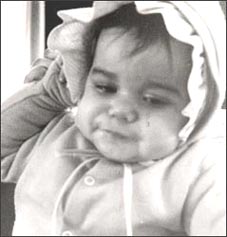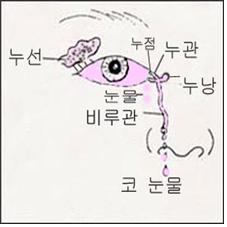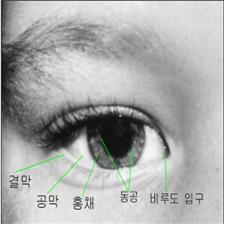눈물이 많이 날 때 (과도 눈물) Excessive tearing(Hyperlacrimation

사진 111. 눈물이 항상 나는 아이
Copyright ⓒ 2011 John Sangwon Lee, M.D., FAAP

그림 112. 누선, 누점, 누낭, 비루관 등에 어떤 이상이 있어도 눈물이 비정상으로 많이 날 수 있다.
Copyright ⓒ 2011 John Sangwon Lee, M.D., FAAP

사진 113. 각막, 동공, 공막, 비루관, 입구(누관 입구), 연
Copyright ⓒ 2011 John Sangwon Lee, M.D., FAAP
-
신생아들이 울 때도 눈에 있는 누선(눈물샘)에서 눈물이 분비된다.
-
그렇지만 신생아들이 울 때 눈물이 뺨으로 흘러내릴 정도로 눈물이 많이 분비되지 않는다.
-
그들의 울음은 바로 그들의 말이다.
-
말할 때 눈물이 나오지 않는 이치와 같게 울음 말로 의사소통을 할 때 눈물이 나오지 않는다.
-
누선에서 분비된 눈물은 각막과 결막을 비롯한 안구 표면을 항상 촉촉이 적시고 안구를 촉촉이 적시고 남은 눈물은 비루관(눈물길/비루관)을 통과해서 비강 속으로 흘러가는 것이 정상이다.
-
선천성으로나 후천성으로 비루도의 일부나 전부가 막힐 수 있다.
-
선천성으로 눈물길의 눈 쪽 입구–누점이 얇은 점막으로 막힐 수 있다.
-
그런 경우 눈물이 눈 쪽 비루관 입구와 비루관 속을 통과해서 비강 속으로 정상적으로 흘러갈 수 없다. 그래서 눈물이 비정상적으로 뺨으로 흐른다.
-
눈 알레르기가 있으면 눈물이 더 많이 나고 알레르기 결막염이 잘 생길 수 있다.
-
알레르기 결막염을 잘 유발 시킬 수 있는 고양이의 털이나 비듬, 또는 집 먼지 좀진드기 등의 항원이 눈에 들어갈 때 눈물이 더 많이 나고 눈이 가려워진다.
-
알레르기 결막염을 일으킨 집 먼지, 집 먼지 좀진드기 등이 없는 곳으로 가면, 알레르기 결막염의 증상 징후가 훨씬 덜해지고 눈물이 덜 나오게 된다.
-
알레르기 결막염은 눈물을 나게 하는 가장 흔한 원인이다.
-
결막염·각막염·녹내장·눈의 티·결막 및, 또는 각막 이물 등이 있을 때 눈물이 많이 난다.
-
이런 병이 있을 때 눈물이 나고 눈물이 나게 하는 원래 병으로 증상 징후가 생길 수 있다.
-
약물 중독·독버섯 중독·농약 중독·최루가스 등으로 인해 눈물이 날 수 있다.
-
눈이 연기·먼지·찬바람 등에 노출될 때도 눈물이 난다.
-
물론 슬프거나 즐거울 때도 눈물이 날 수 있다.
-
비정상적으로 눈물이 항상 많이 나거나 눈물이 뺨으로 흘러내리면 의사에게 문의한다.
|
다음은 “찬바람에 눈물이 나요”에 관한 인터넷 소아청소년 건강상담 질의응답의 예 입니다. |
Q&A. 찬바람에 눈물이 나요
Q.
어른들도 가끔 눈에 바람이 들어가면 눈물이 나잖아요. 근데 이 아이는 겨울엔 바깥에만 나가면 꼭 눈물이 나요. 물론 겨울이라 찬바람이 심하긴 하지만 매번 눈물이 울듯이 흘러내릴 정도로 많이 나니까 혹시나 검사를 받아야하나 싶어서 걱정이 되네요.
이제 31개월 되었구요. 엄마가 일을 하는 터라 매일 놀이방을 가야한답니다.
A.
배암님
안녕하세요. 좋은 질문을 해 주셔 감사합니다.
자녀의 나이, 성별, 과거 병력, 가족 병력, 진찰소견, 임상검사의 결과 등의 정보가 있으면 더 좋은 답변을 드릴 수 있지만 주신 정보를 토대로 해서 답변을 드리겠습니다.
사실은 이런 질문을 처음 받는 것 같습니다.
왜 그런지 확실히 답변을 드릴 수는 없지만 이렇게 생각을 해볼 수 있습니다.
찬바람을 쏘이면 후두, 기관과 기관지 등 하기도가 찬바람을 자극 받아 수축될 수 있고 그로 인해서 천식 발작이 유발될 수 있고 기침 하고 가래를 뱉을 수 있습니다.
이런 천식을 한랭 유발성 천식이라고 합니다.
찬바람에 쏘이면 비강내 점막층의 감수성이 예민해지고 콧물이 많이 날 수 있습니다.
이것은 보통 있는 현상입니다.
눈 결막이 찬바람으로 자극받고 눈물샘도 자극받아 눈물이 많이 나는 것일 것입니다.
즉 물리적인 자극으로 인해서 눈물이 많이 날 수 있을 수 있습니다.
또 찬바람과 함께 온 자극성 물질이 눈으로 들어올 때 그 자극성 물질을 씻어내기 위해서 눈물이 더 많이 날 수 있습니다.
그 외로 교감 부교감 신경이 좀 더 예민한 사람들은 콧물이나 눈물을 더 잘 흘일 수 있습니다. 이렇게 생각해 봤습니다.
소아청소년과에서 진찰 진단을 받으시고 아무 이상이 없는데도 그런 현상이 생기면 아마도 그 문제는 위에서 말씀드린 이유로 생긴다고 할 수 있습니다.
눈물이 많이 날 때를 참조하시기 바랍니다. 질문이 더 있으면 또 방문하세요. 감사합니다. 이상원 드림
Excessive tearing (Hyperlacrimation) 눈물이 많이 날 때 (과도 눈물)

Photo 111. A child who always cries Copyright ⓒ 2011 John Sangwon Lee, M.D., FAAP

Figure 112. Any abnormality in lacrimal glands, lacrimal ducts, lacrimal sacs, and nasolacrimal ducts can cause abnormal tears. Copyright ⓒ 2011 John Sangwon Lee, M.D., FAAP
Picture 113. Cornea, pupil, sclera, nasolacrimal duct, entrance (entrance of fistula), soft Copyright ⓒ 2011 John Sangwon Lee, M.D., FAAP
• Even when newborns cry, tears are secreted from the lacrimal glands in the eyes.
• However, when newborns cry, they do not produce enough tears to run down their cheeks.
• Their cries are their words.
• Tears don’t come out when communicating with words.
• Tears secreted from lacrimal gland always moisten the surface of the eyeball, including the cornea and conjunctiva, and it is normal for the remaining tears to pass through the nasolacrimal duct (tear duct/nasolacrimal duct) and flow into the nasal cavity.
• Part or all of the virulence may be blocked either congenitally or acquired.
• Congenitally, the eye-opening of the lacrimal duct may be blocked with a thin mucous membrane.
• In such a case, tears cannot flow normally through the nasolacrimal duct in the eye and through the nasolacrimal duct into the nasal cavity. So tears flow abnormally down the cheeks.
• If you have eye allergies, you may experience more tearing and allergic conjunctivitis.
• When allergens such as cat hair, dander, or house dust mites, which can cause allergic conjunctivitis, enter the eyes, more tears and itchy eyes occur.
• If you go to an area free of house dust, dust mites, etc. that cause allergic conjunctivitis, the symptoms of allergic conjunctivitis will be much less and you will have fewer tears.
• Allergic conjunctivitis is the most common cause of tearing.
• Conjunctivitis
• Keratitis
• Glaucoma
• Tear of the eye
• Conjunctiva and/or corneal foreign body causes a lot of tears.
• When you have this disease, you may have symptoms that are the original disease that causes tears and tears.
• Drug poisoning, poisonous mushroom poisoning, pesticide poisoning, tear gas, etc. may cause tears.
• Tears also form when your eyes are exposed to smoke, dust, or cold wind.
• Of course, tears can come when you are sad or happy.
• Contact your doctor if you have unusually frequent tears or tears running down your cheeks.
The following is an example of a Q&A on health counseling for children and adolescents on the Internet about “I cry in the cold wind”.
Q&A.
I cry in the cold wind
Q. Even adults sometimes cry when wind gets in their eyes. But this child always sheds tears whenever he goes outside in winter. Of course, it’s winter, so the cold wind is strong, but tears flow down like tears every time, so I’m worried that I might have to get a test. It’s now 31 months. Because her mother works, she has to go to the playroom every day.
A.
Bae Am Good morning. Thanks for asking a good question. We can give you a better answer if you have information such as your child’s age, gender, past medical history, family history, examination findings, and results of clinical tests, but we will give you an answer based on the information you have given us.
In fact, this seems to be the first time I have been asked this question.
I can’t give you a definitive answer as to why, but you can think of it this way. When cold wind blows, the lower respiratory tract, such as the larynx, trachea, and bronchi, can contract due to stimulation of the cold wind, which can cause asthma attacks, and can cause coughing and sputum.
This type of asthma is called cold-induced asthma. If you are stung by a cold wind, the sensitivity of the mucous membrane in the nasal passages becomes sensitive and you may have a runny nose.
This is a common phenomenon.
The conjunctiva of the eyes is stimulated by the cold wind and the lacrimal glands are also stimulated, so it is possible that there are many tears. In other words, physical stimulation may cause a lot of tears. Also, when an irritant from the cold wind enters the eye, more tears may be shed to wash the irritant.
In addition, people with more sensitive sympathetic and parasympathetic nerves may be more prone to runny nose and tears.
I thought about it this way. If you receive a diagnosis from the Department of Pediatrics and there is no abnormality, the problem is probably due to the reasons mentioned above. Please refer to When there are many tears. Please visit again if you have more questions. Thank you. Lee Sang-won .;MD
출처 및 참조문헌
- www.drleepediatrics.com 제 6권 신생아 성장 발육 육아 질병
-
www.drleepediatrics.com제7권 소아청소년 감염병
- www.drleepediatrics.com제8권 소아청소년 호흡기 질환
- www.drleepediatrics.com제9권 소아청소년 소화기 질환
- www.drleepediatrics.com제10권. 소아청소년 신장 비뇨 생식기 질환
- www.drleepediatrics.com제11권. 소아청소년 심장 혈관계 질환
- www.drleepediatrics.com제12권. 소아청소년 신경 정신 질환, 행동 수면 문제
- www.drleepediatrics.com제13권. 소아청소년 혈액, 림프, 종양 질환
- www.drleepediatrics.com제14권. 소아청소년 내분비, 유전, 염색체, 대사, 희귀병
- www.drleepediatrics.com제15권. 소아청소년 알레르기, 자가 면역질환
- www.drleepediatrics.com제17권. 소아청소년 피부 질환
- www.drleepediatrics.com제18권. 소아청소년 이비인후(귀 코 인두 후두) 질환
- www.drleepediatrics.com제19권. 소아청소년 안과 (눈)질환
- Red book 29th-31st edition 2021
- Nelson Text Book of Pediatrics 19th — 21st Edition
- The Johns Hopkins Hospital, The Harriet Lane Handbook, 22nd edition
-
누낭염 (Dacryocystitis)
-
비루도 통과부전(Nasolacrimal duct obstrution)
-
안구 건조증(Dry eye/Dry eye Syndrome)
-
Childhood Emergencies in the Office, Hospital and Community, American Academy of Pediatrics
-
Emergency Medical Service for Children, By Ross Lab. May 1989. p.10
-
Emergency care, Harvey grant, and Robert Murray
-
Emergency Care Transportation of Sick and Injured American Academy of Orthopaedic Surgeons
-
Emergency Pediatrics A Guide to Ambulatory Care, Roger M. Barkin, Peter Rosen
-
Immediate care of the acutely ill and injured, Hugh E. Stephenson, Jr
-
The Critically Ill Child, Diagnosis and Management, Edited by Clement A. Smith
-
Emergency Medical Services for Children: The Role of the Primary Care Provider, America Academy of Pediatrics
-
Quick Reference To Pediatric Emergencies, Delmer J. Pascoe, M.D., Moses Grossman, M.D. with 26 contributors
-
Manual of Emergency Care
-
응급환자관리 정담미디어
-
소아가정간호백과–부모도 반의사가 되어야 한다, 이상원
-
Neonatal Resuscitation American heart Association
-
Neonatology Jeffrey J.Pomerance, C. Joan Richardson
-
Pediatric Resuscitation Pediatric Clinics of North America, Stephen M. Schexnayder, M.D.
-
Pediatric Critical Care, Pediatric Clinics of North America, James P. Orlowski, M.D.
-
Preparation for Birth. Beverly Savage and Dianna Smith
- Infectious disease of children, Saul Krugman, Samuel L Katz, Ann A. Gershon, Catherine Wilfert
-
The Harriet Lane Handbook 19th Edition
-
소아과학 대한교과서
-
제1권 소아청소년 응급의료 참조문헌과 출처
-
Other
Copyright ⓒ 2015 John Sangwon Lee, MD., FAAP
“부모도 반의사가 되어야 한다”-내용은 여러분들의 의사로부터 얻은 정보와 진료를 대신할 수 없습니다.
“The information contained in this publication should not be used as a substitute for the medical care and advice of your doctor. There may be variations in treatment that your doctor may recommend based on individual facts and circumstances. “Parental education is the best medicine.”